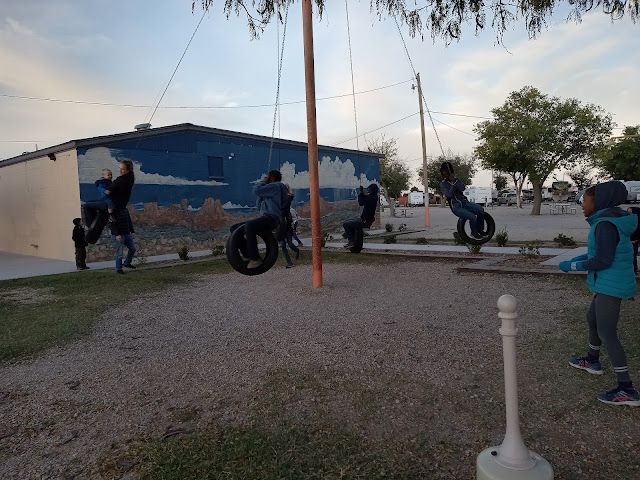Arising early on the nippy morning of the fifth day of our grand western trip, we scurried to disassemble camp so that we might quickly head on our way. The Carlsbad RV Park was remarkable to each of us because of the huge tire-go-round in the park that mimicked the modest version we had at home. We had never encountered one anywhere else, and the children and grandchildren delighted in employing it well while they could!
The morning chill gave way to sunshine as we found ourselves dropping down out of New Mexico into West Texas and the Guadalupe Mountains National Park.
The range, located in the vast Chihuahuan Desert, is home to a stop of the Butterfield Overland Mail, as well as a site called Frijole Ranch. It was fascinating to see the remains of a stop where stagecoaches carried mail cross-country during the era when the Pony Express operated simultaneously.
After we decided to visit the ranch, I ruminated on whatever could be of interest on a “bean farm” out west in this dry barrenness that could grow little. I would be surprised!
From that oasis, we headed west with the grand view of El Capitan, the iconic eighth highest peak in Texas, standing sentinel over the desert valley floor below.
The historic cultural landscape was a museum in self-reliance! Frijole Ranch, a house and grounds on the National Register of Historic Sites, was built with native materials in an area of the Guadalupe Mountains that contained springs. The oasis was budding with life! There were majestic pecan trees and orchards. Green grass abounded in stark contrast to the surrounding desert. Who would have thought this possible? A resourceful John Thomas and Nella May Smith moved to the homestead in the summer of 1906. They made a living primarily from truck farming and their small orchard. With their several spring houses and pumps, they watered both the farm and the house. Along with their ten children, they grew apples, peaches, apricots, plums, pears, figs, pecans, blackberries, strawberries, and corn at the edge of the dry, lower slopes of the Guadalupe escarpment. This ranch stood as a testament to the pioneering, rugged spirit of the American West.
From that oasis, we headed west with the grand view of El Capitan, the iconic eighth highest peak in Texas, standing sentinel over the desert valley floor below.
We stopped at a scenic bypass to snap a photo of “The Captain,” to remember the moment long after it had passed. The dramatic limestone landmark rose boldly behind us, its sheer walls thrusting to the sky.
Descending into the salt flats, we traveled the one hundred miles or so to the west Texas town of El Paso. The town brought reminiscences of our trip twenty-five years ago. It was in El Paso that we realized we were leaving friends and family far behind on our relocation west. It was a sobering realization. There also, we gazed across the Rio Grande, smaller than our expectations, to see Juarez across the US border into Mexico. It was sad to see the shabbily constructed homes. It made us appreciate how prosperous life was on this side of the border.
Descending into the salt flats, we traveled the one hundred miles or so to the west Texas town of El Paso. The town brought reminiscences of our trip twenty-five years ago. It was in El Paso that we realized we were leaving friends and family far behind on our relocation west. It was a sobering realization. There also, we gazed across the Rio Grande, smaller than our expectations, to see Juarez across the US border into Mexico. It was sad to see the shabbily constructed homes. It made us appreciate how prosperous life was on this side of the border.
This time, with an ornate border wall defining the border, Juarez looked to be a prosperous town. There were no longer shanties, only nice dwellings, businesses, and amusement parks. Time had changed a lot.
We ultimately crossed the Arizona border and located our stopping place for the night in Wilcox. We had experienced quite a day, but the high point, figuratively speaking, was saluting “The Captain.” The day had brought scores of interesting sites and reminiscences. Our journey was sure to provide countless more occasions in the ensuing days.
~Rhonda









.JPG)
.JPG)
No comments:
Post a Comment